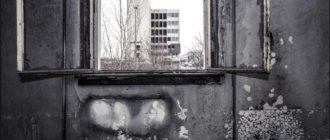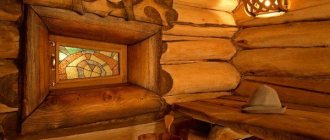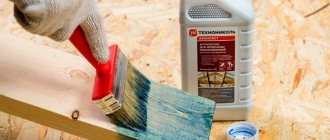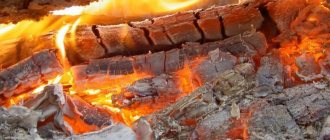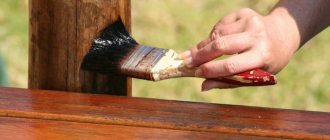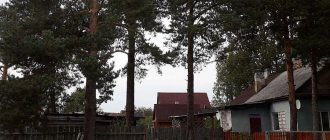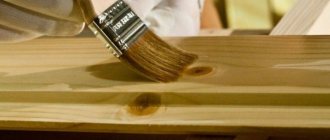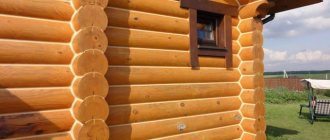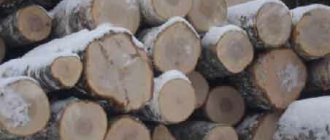How to remove soot from wood: the most effective solutions Almost every one of us at least once in our lives is faced with the problem of having to clean soot from a wooden surface. Soot deposits on wood can form in any type of wooden structure that does not have centralized or electric heating. This could be a wooden house in the village or a country cottage, heated by a stove or fireplace, a bathhouse, a gazebo with an installed barbecue, a summer kitchen with a stove for cooking. When any type of fuel is burned, the combustion products contain soot particles, which not only settle on the wooden surface, but also penetrate deep into the untreated or uncoated wood. In this case, washing off the soot becomes a real problem. Let's look at several ways to remove soot deposits from a wooden surface to choose the most effective one.
Washing off soot in a bathhouse
MAZBIT PLUS - Concentrated product designed to clean surfaces from the effects of fire.
Designed for effective quick cleaning of any surfaces: general construction materials: wood, concrete, plaster, stone, tiles from various contaminations by combustion products: soot, soot, carbon deposits.
More details
If the wooden elements around are covered with a black layer, they are quite difficult to clean manually.
But there are several options for removing soot from a tree.
Regardless of the origin of the soot - in the bathhouse from the stove, or it is a consequence of a fire, it is necessary to urgently resolve the issue of how to wash soot from wood.
If we talk about soot that formed after a fire, the most effective way to remove it is to use special chemicals. With their help you:
- effectively remove soot from all wooden surfaces;
- you can clean even the most difficult to reach places;
- clean small parts (in the case of furniture, this could be carvings or some kind of decor);
- you will clean without damaging the texture and color of the wood;
- completely get rid of the burning smell.
The cleaning process should begin with the need to assess how damaged the wooden product is and decide whether it can be restored.
After this, the top non-ingrained layer of soot is removed using a powerful vacuum cleaner.
The next stage is washing the wood.
Before you wash soot from a tree, you need to choose a quality product and become thoroughly familiar with its composition and instructions. The main components that will gently remove soot from wood are alkali and organic detergent additives. They should form the basis of the product.
In accordance with the instructions, it is necessary to prepare a solution and treat the contaminated surface with it, then rinse with clean water. This way you can clean the room, both inside and outside, while completely getting rid of the burning smell.
In case of soot formation in a wooden bath, it is also recommended to use special chemical compounds. Here, among other advantages, there is one more very important one. Since the temperature in the bathhouse is always high, some substances remaining after cleaning the room can emit harmful fumes, but modern products are designed taking this feature into account and eliminate this possibility. Therefore, they can effectively clean the bathhouse without harming your health.
There are also some folk remedies that you can use to try to wash off the soot.
This could be using a spatula to scrape it off or some kind of abrasive.
This, of course, is more profitable from an economic point of view, but before you wash soot from a tree in this way, it is worth considering what condition the wood will be in after this. After all, intense mechanical impact can damage its surface; moreover, this method requires a lot of labor and takes a lot of time.
Many owners are wondering how to wash off soot in a bathhouse with their own hands. Experts say: there are two cleaning methods - using mechanical devices and using various chemical compounds. Let's take a closer look at both methods.
Soot often forms on the walls and ceiling in the bathhouse
The formation of smoke in the furnace occurs due to the low combustion temperature of the fuel in it. But good draft in the chimney removes all the smoke outside. The release of smoky combustion products into the room occurs in cases where the movement of air in the stove system is difficult. With weak draft, it is impossible to even simply open the firebox door without clouds of smoke escaping from it.
The reasons for poor air movement in the furnace can be different:
- Errors during construction. They can only be corrected by rearranging the entire structure.
- A reduction in the cross-section of the pipe due to a foreign object getting inside or the chimney being heavily clogged with soot.
- Cracks in the stove masonry through which air is drawn in, disrupting normal circulation.
- Weak oxygen flow from the blower. This can happen when the door is not open enough. Sometimes the ash pit simply becomes clogged with ash from previous kindlings.
- There is a strong wind outside, preventing smoke from coming out of the chimney normally. Partially, a skate installed at the top can help with this problem, but if the wind direction is unfavorable, it won’t help either.
- Smoke at the beginning of kindling after a long break. In such cases, before lighting, you need to warm up the stove riser by burning several newspapers or a rag doused with gasoline in it.
- When lighting a stove with raw wood, the smoking will stop only after the firebox and chimney have been warmed up for a long time.
You will have to constantly wash off the soot in the bathhouse when installing a heater that is heated “black”. In this case, the soot will come out along with the steam.
The soot that escapes from the stove settles everywhere inside the steam room - on the walls, ceiling, brickwork and metal parts of the stove, and on the window glass. Each of the materials stained with soot requires its own means with which it is more convenient to clean it.
It is most difficult to remove soot from wooden walls and ceilings in a bathhouse. Simply removing it with soapy water will not work. Soot does not dissolve well and simply spreads over the surface. Wood is a hygroscopic material, and soot particles penetrate inside along with water, penetrating into small pores and cracks. It will be impossible to wipe them off after this. You will have to remove the top layer of the wooden covering along with the ingrained soot.
Mechanical method
You can remove soot from brick and wood with a stiff brush.
To remove black deposits on walls and ceilings effectively and without the risk of getting into the pores of the wood, you need to scrape them off. This is long and tedious, since considerable physical effort is required even when processing smooth surfaces.
Soot must be picked out from joints and cracks using sharp objects or special brushes. In addition, such actions lead to damage to the upper layers of wood with which the steam room is sheathed. The result is clean walls without any soot residue.
We suggest you familiarize yourself with What is cake mastic and how to make it yourself? How to sculpt cake figures from fondant?
Chemical method
Using detergents to remove soot saves effort and time. But you need to be careful when choosing chemicals.
The basis of the composition of soot is carbon, and it practically does not dissolve in anything. Using strong chemicals with acids will damage the structure of the wood. To remove soot, alkali-based wash-off compounds are used. They clean off carbon deposits, but do not harm the wood surface.
When removing soot and soot, wear protective clothing
Before you begin cleaning the bathhouse in any way, you must take measures to prevent the spread of removed soot particles:
- Go over all contaminated surfaces with a vacuum cleaner.
- Cover the floor and shelves with polyethylene or paper.
- Wear protective clothing, rubber gloves on your hands, and a mask on your face.
- Brush off the top layer of soot with a broom or hard bristle brush.
Only after these steps can you begin the main removal of contaminants.
The best folk remedies for disinfection against mold and mildew
It is no more difficult to clean soot from a wooden floor in a bathhouse than it is to clean the walls or ceiling. But it is recommended not to use chemicals to clean it, but to use scrapers and abrasives. The floor is constantly exposed to moisture, so the soot does not linger on the surface of the wood, but eats into it.
Disinfection of a bathhouse, carried out at home, consists of removing traces of rotting and prophylactically applying compounds that protect the wood from fungus.
You can remove mold that has appeared on the boards by wiping the infected areas with the following substances:
- Any antiseptics containing chlorine. It is not recommended to use regular bleach due to its effect on wooden surfaces.
- Ethanol. It removes putrefactive deposits well, but it cannot be used simultaneously with chlorine-containing cleaners.
- A weak solution of potassium permanganate.
- Self-prepared antiseptic. To 1 liter of water add 18 g of table salt, 22 g of iron sulfate, 44 g of potassium alum.
After wiping with a disinfectant, it is necessary to apply prophylactic compounds to prevent a new infection.
When purchasing antiseptics in a store, you need to choose them taking into account the special conditions in the steam room - high temperatures and humidity. It is also necessary that the applied substance does not interfere with the wood’s “breathing”, that is, it is vapor permeable.
The chimney in the bathhouse must be regularly cleaned of soot with a hard brush.
The main obstacle to the escape of smoke from the stove into the steam room is the good condition of the smoke exhaust channels. To maintain draft in the chimney, measures must be taken regularly:
- Monitor the condition of the brickwork. Any cracks in it must be immediately sealed with cement mortar.
- Clean the chimney from soot deposits inside. You don’t even have to buy special compounds, but use used bath brooms. They need to be tied in a bunch with the branches down, attached to a long rope and hung with a load.
- If it is not possible to clean the stove by mechanical means, you sometimes need to heat it with special chimney sweep logs. Alder or aspen firewood, or potato peelings are suitable for this purpose.
- Rake out the ash from the ash pit after each fire of the stove.
- Clean the entire steam room several times a year with a soda solution and a stiff brush.
If a hot water supply is connected to the room, it is recommended to spray the walls and ceiling with a pressure hose in a cooled bath.
Why does the chimney become dirty?
How to clean a chimney in a bathhouse depends on the nature of the contamination. With use, types of clogging may occur such as:
- soot and soot, which accumulates very quickly when burning household waste;
- condensation that forms due to irregular use of the bathhouse;
- foreign objects accidentally falling into the chimney.
All of these types of contaminants ultimately impede the free circulation of air and the escape of smoke through the chimney. This may cause carbon monoxide poisoning. Condensate is a weakly concentrated acid solution. Under its influence, the chimney masonry begins to collapse from resinous deposits.
If you use a sauna regularly, you need to make a schedule and determine in advance when and how to clean the pipe in the sauna. Carrying out such work regularly will preserve the chimney and stove and allow you to use the sauna without any problems.
The chimney and pipe in the bathhouse are cleaned chemically and/or mechanically. In a special store you can purchase liquids and/or powders for cleaning the chimney. Detailed instructions are printed on the packaging. After reading it, it will become clear how to clean a pipe in a bathhouse.
A good answer to the question of how to clean soot in a bathhouse that has accumulated in a chimney would be a “log chimney sweep.” It is impregnated with special chemicals. During combustion in the furnace, smoke of a special composition is released. As a result, the soot becomes soft and pliable. After 2 or 3 days it can be removed with brushes without much difficulty.
For mechanical cleaning of the chimney you will need the following tools and devices:
- rope and/or rope;
- weight (ball);
- brush-ruff (preferably on a thin metal cable).
First you need to check the safety of the structure. Then you need to remove any objects that accidentally got into them from the pipe and chimney. For this purpose, a brush-ruff is used, selected according to the size and shape of the pipe.
A special modern brush will make cleaning work easier. It comes with a handle consisting of several links. This allows you to adjust the length of the brush as needed. During cleaning work, any brush must be moved inside the pipe, gradually moving it lower and lower.
Such work must be performed in a special set of clothing, which must include:
- overalls or suit;
- respirator;
- gloves;
- protective glasses.
If the chimney is not very dirty, you can call a specialist. He will clean it using a special high-power vacuum cleaner. This will remove soot from the chimney through the firebox opening. The use of special means will help resolve the issue of how to clean the chimney of contaminants and how to clean the pipe of soot in a bathhouse.
Bath disinfection
Chemical method
- If soot accumulates and a whole layer of black mass forms, it can be removed by simply scraping it off the surface using sharp objects (scraper, knife, spatula, etc.). When carrying out major repair work, wooden surfaces are cleaned with a sanding machine or a special attachment for a drill or grinder. The soot is removed along with the top layer of the tree, updating the environment. But such cleanings cannot be carried out frequently so as not to completely destroy the wooden surface. Dry cleaning of soot is a very dusty and dirty undertaking that requires time and physical effort.
- Washing off soot with a simple soap solution is the job of a real housewife who loves cleanliness and order. But the soot absorbed into the wooden surface is simply rubbed off with a wet rag or brush and remains on your hands. Even active detergents that break down fats do not give the desired result.
- Workers in the chemical industry suggest how to remove soot from a wooden surface and return the wood to its natural pattern. They have already developed a product that reacts chemically with combustion residues. It is worth applying it to the contaminated surface, wait for the time specified in the instructions, and then rinse completely with plenty of water. The result will be flawless and your hands will remain clean!
Our company’s specialists recommend using a modern chemical product to remove soot from wooden surfaces. Check out the quality characteristics of the product on our website. Buy special equipment in the required quantity. Save yourself the extra physical effort and get excellent results in cleaning wooden surfaces from soot deposits!
First of all, you can use traditional methods.
If you have sand or grated brick nearby, you can use them.
This is a perfectly acceptable cleaning method. But it has a big flaw.
After the soot is removed, you will find scratches on the surface. By the way, scratches can later become the basis for even more soot contamination. If this doesn't matter, you can safely get down to business.
When the appearance needs to be preserved, it is better to consider other methods.
How else can you remove soot from a tree? You can more thoroughly clean wood from soot mechanically. Cleaning should be done with a spatula or, better yet, a sander.
This option is very good if you decide to clean a large area. Then the whole tree will be the same color. If you remove a layer in only one place, it will already differ from the rest of the wood.
We suggest you read How to remove ink from linoleum - MOREREMONTA
After cleaning with a sander, there will be a lot of dust around. This will require washing the wood and area.
There are often knots on the tree itself, which will complicate the work. So, if you have time and tools, you can easily deal with soot deposits.
The chemical cleaning method, today, can be called the most common, and most importantly, effective.
You can find professional chemicals in city stores. Sales consultants will select the best option for processing and help you find how to remove soot from a tree.
The chemicals that are part of modern chemical products not only clean, but also protect the wood for a long time from new plaque.
In order to apply the chemical correctly, you need to apply the solution with a brush to the soot and wash it off after some time. This option will help save not only your time, but also money. New soot removal will not be needed soon.
Wash wooden surfaces with soapy water. The effect will certainly be achieved if the wood is covered with a protective layer of varnish, paint, or at least sanded. But divorces will remain for a long time. This method is very labor-intensive and time-consuming.
You can remove a layer of soot from untreated wood with a sharp scraper or sanding wheel. The work requires diligence and care. Then the dust needs to be swept away, the wooden surface will look like new. Wood can be subjected to this treatment no more than 1-2 times.
The chemical industry has made sure that layers of soot can be removed from the tree without damaging it. A special water-based remover is applied to a wooden surface covered with soot. A reaction occurs that splits soot particles, which are then easily washed off with ordinary water or wiped with a rag. The room and the wooden objects in it are cleaned quickly and efficiently. Even the persistent burning smell disappears.
Mechanical removal of soot involves manual cleaning, which is a labor-intensive procedure that takes a lot of time and effort. In addition, the result often does not meet expectations. During manual processing, the top layer of dark plaque is removed from the surface of the wood using sandpaper. After completing the process, the surface is rinsed with water.
A special chemical soot remover acts gently and accurately, quickly pushing out soot and dirt from the surface of the wood. Such compositions are hypoallergenic and safe, they can be used both in large enterprises and at home.
Advantages of the chemical:
- high efficiency;
- absence of hazardous components;
- economical due to high concentration;
- convenience and safety of use.
Note: before using chemical compounds to remove soot, carefully read the manufacturer’s instructions and recommendations for use. Application time varies depending on the composition and purpose. If the chemical comes into contact with your skin, rinse the affected area with plenty of water and seek medical advice.
A variety of stain-fighting chemicals
The compositions described above do not work, and you don’t know how to remove soot? Try using acetone, or if you don’t have it, use manicure remover. We soak a piece of clean soft cloth in the selected liquid and treat the problem area. After application, leave the product for half an hour, then rinse under the tap. The final step is standard washing. Often high-quality stain removers come to the rescue. Make sure that the product you buy removes greasy stains well. We read the instructions, apply the stain remover to the fabric correctly, and then wash the item. Strictly follow the instructions on the packaging so that the composition works and saves the damaged product.
Turpentine is perfect for removing traces left by coal, soot, soot and ash. Cleaning in this way has certain features. First of all, take clean turpentine and apply it to the stained area. Using a rag, we wipe the area of contamination, then take a brush, moisten it in high concentration soapy water and walk over the surface of the material. After this treatment, all that remains is to wash the wardrobe item. To save seriously contaminated fabric, take turpentine and raw egg yolk in equal proportions, mix, heat, treat the stain and wash the item.
Basic recommendations
Soot, also called soot or soot, is small particles of materials that have not burned completely. In order to wash it, you will have to use fairly aggressive methods. The main feature is that soot has one very insidious property: if you add even a little water to it, it will turn from a dry substance into a fatty sticky mass.
When talking about how to clean soot, you should pay attention to the fact that you need to exclude the following products:
- water;
- liquid or laundry soap;
- sponges and any hard brushes.
All of the above products can be used only after carbon deposits have been removed from wood or other surfaces. In order to clean soot from surfaces, it is necessary to use personal protective equipment. You will need:
- glasses;
- robe;
- headwear, such as a cap or scarf;
- respirator (you can replace it with a regular gauze bandage);
- latex gloves.
Preparation
Before you start fighting black plaque, take care of your own safety and stock up on the necessary equipment. Carry out all work wearing gloves, a respirator, protective clothing, and a hat. You will need:
- vacuum cleaner or broom;
- rags;
- household washcloths;
- putty knife;
- hard bristle brush;
- mop with telescopic handle;
- detergents.
Clear the room to be cleaned of furniture and other objects that could get soot on it. Dispose of items that cannot be restored. Carry out work in a ventilated room.
Washing off soot in a bathhouse
Chemical method
The first thing to do is to sweep the soot with a dry, stiff brush onto the oilcloth or newspaper. After this, you should use a sponge soaked in a special chemical composition. You can buy it at a hardware store. Use this sponge to thoroughly clean the surface. The next stage is wet cleaning with detergents that can dissolve grease.
It's a little more difficult to work with soot on the ceiling. The fact is that ceiling coatings can be different, and therefore general cleaning techniques may not be suitable for a particular surface. The easiest way to remove soot is on a glass ceiling. To do this, just apply a liquid suitable for cleaning windows, gently wipe with crumpled newspaper, and then use a soft, dry cloth.
It is a little more difficult to work with a wooden ceiling. How to remove soot from such a coating? A proven old-fashioned method will do: rub the ceiling with river sand or red brick. The most difficult coating to clean will be water-based paint or whitewash. Small stains can be removed with salt, but if the entire ceiling is smoked, only new paint will save it.
But the soot still needs to be removed first, because the paint won’t adhere to it. How to do it? Clean the surface thoroughly with a dry brush and then wipe with rubbing alcohol. If the fire was large, you should invite professionals: cleaning service specialists have professional cleaning products that are extremely difficult to find in a regular store.
Cleaning the apartment must be done thoroughly and promptly. After the incident, there are a lot of dangerous substances and objects in the apartment. Black soot deposits on the walls and a heavy burning smell eat into wooden surfaces and can remain for a long time. Household appliances and furniture melt under the influence of high temperatures and are soldered to each other and other surfaces, damaging floors and walls, and after extinguishing with water, high humidity remains in the apartment, which creates a threat of mold and fungi.
We suggest you familiarize yourself with How to remove rust from a car from all parts of the body, treatment
Cleaning up after a fire should be carried out in special uniforms that provide skin protection and respirators to protect the respiratory system. Cleaning company specialists provide their services at affordable prices, which vary depending on the area of the room, the complexity of the work, the need to use specific chemicals, and the use of additional tools and services.
Clean up soot after fires
Fire or smoke leads to damage to property, loss of human life and health, and other irreparable consequences.
Afterwards, the room is covered with black spots and filled with a burning smell. Even carrying out repair work does not always solve this problem. This can be done if you act correctly, from garbage collection to air freshening. Important!
Do not try to remove soot using a damp cloth or soft sponge soaked in clean water. Thus, the contamination will only increase in size and cannot be removed.
Garbage collection
The first step in soot removal is removing debris. All unusable damaged objects must be removed from the premises: furniture, books, remnants of clothing, etc. If the walls have managed to smoke, then the finishing material must be carefully removed from them with a spatula.
We will also have to say goodbye to those objects that were not damaged by the fire. These include wooden furniture, windows, doors and decor. They have the ability to quickly absorb odors, so even after all soot stains have been removed, a burning smell may continue to be present in the room. Before you take them to the trash, you need to try to eliminate the odor by taking them out into the fresh air or treating them with a special solution.
Dry processing
After removing the debris, you can begin dry cleaning the affected areas. This requires several steps:
- Cover the flooring with film.
- Using a spatula, remove the finishing coating from the walls.
- Use a vacuum cleaner or stiff brush to remove soot from the ceiling and walls.
- Remove soot from corners or cracks.
- Remove dirt from the floor.
Garbage collection and dry processing boils down to the removal of all objects that contain a burning smell or soot from the room. After this, it will be easier to clean the walls after a fire with special compounds.
Wet processing
When carrying out wet cleaning to remove carbon deposits, you need to use a folk remedy (soda or soap solution), a professional kit or a ready-made product. They need to carefully remove soot from the ceiling, then continue wet cleaning from top to bottom. After completing this action, it is recommended to additionally treat each surface with a primer to level the damaged walls.
Air purification
Another important step in eliminating traces of a fire is air purification. For this purpose, it is recommended to use special disinfectants or an ozonizer that helps instantly eliminate carbon compounds. To do this, just turn on the device and in a few days it will completely eliminate the unpleasant odor from all surfaces and objects.
If there is no ozonizer and a special disinfectant, then you can try to eliminate the unpleasant aroma using the folk method.
It is simpler, less expensive, but also less effective. To implement it, you need to pour water into a deep saucepan with a dense bottom and boil the liquid for several hours. Thus, the air will be saturated with hot moisture, and under the influence of steam, the burning smell will disappear. Important!
Of course, for a single air purification you do not need to buy an expensive ozonizer. Currently, in every city there are cleaning services where you can rent this equipment.
Tools and products used during cleaning
When choosing mechanical soot removal, the following are used:
- various brushes with hard or metal bristles;
- sharpened metal scrapers or spatulas;
- a sharp knife or awl to remove soot from cracks and joints;
- special narrow brushes for the same purpose;
- sandpaper of different grain sizes;
- grinder with flap type grinding wheels.
Awl - for removing soot from narrow crevices Flap-type grinding wheel for cleaning large surfaces with a grinder Melamine sponge for small, light dirt
A light coating of soot is wiped off with a melamine sponge, which acts like an eraser. But it wears out quickly, and several pieces will be needed to tidy up a large area.
Good results can be achieved by using folk cleaning agents - crushed brick or fine sand. You need to wash off soot with their help by pouring a layer of such abrasive onto a thick brush or hard sponge, and then wipe the contaminated areas.
Docker Mazbit plus - an effective remedy for soot and soot
To clean the bathhouse from soot deposits using a chemical method, you can purchase specialized cleaning agents:
- Mazbit. Designed to remove fire marks on wooden surfaces. Easily cleans off fresh soot, preventing it from penetrating into cracks and pores.
- BZ-20. Alkaline cleaner used to remove greasy, sooty marks.
- Facade cleaner No. 2. In addition to washing soot, it disinfects, neutralizing substances with carcinogenic effects.
- Clean-Dezo. Used at the final stage to eliminate the burning smell.
Traditional methods
Vinegar essence diluted with water in a ratio of 1:2 helps to wash off soot from stove bricks. The solution is applied with a sponge to the smoked masonry, and after 10–15 minutes it is washed off with a damp cloth. To remove a dense layer of soot, vinegar is not diluted.
You can clean soot from bricks with ammonia. But then you will have to ventilate the bathhouse for a long time to remove its smell.
Can soot be safely removed from ceilings, floors and walls? Of course yes! To do this, you will need a scraper with a sharp base or a regular spatula. Using these items you can dry clean any surface from dirt. True, this will require a lot of free time and physical strength.
By the way, the easiest way to prevent serious contamination: to do this, after completing each fire of the sauna stove, you need to take a soft brush, which is intended for wood, and clean the floor and walls of the sauna. Another mechanical method is to use a grinding machine, the flap-type wheel of which has a diameter of up to 12 cm and a grain size of 35 units. Of course, as a result of the work, a large amount of dust will appear, but it can be quickly and easily removed using a clean rag and soap solution.
Air purification
Having gotten rid of visible traces of soot, take care of eliminating those that are tangible to the respiratory organs. An ozonator will help out by pouring a spoonful of soda into the container and adding 3-5 drops of ammonia and hydrochloric acid. Leave the mixture indoors for a day, followed by ventilation. Gary is gone!
So, it is possible to get rid of soot and unpleasant odors. Sometimes it doesn't even require a lot of money. All you need: ingenuity, home (but preferably professional) remedies and strict adherence to the specified recommendations.
Save and share information on social networks:
Mechanical method of cleaning surfaces from soot deposits
How to wash soot off walls, floors and ceilings in a bathhouse? Liquid chemical compositions, which can be purchased at a hardware store, are ideal. They should be applied to the surface, following the rules specified in the instructions, and after a certain period of time, washed off along with the dirt. Most highly concentrated chemical preparations contain alkaline components that quickly remove soot without damaging the structure of the tree.
Are you wondering how to remove soot from a wall or ceiling? Use chemical sponges that are soaked in deep penetration substances. They will easily remove the smallest particles of soot that have penetrated the wood structure. The principle of operation is quite simple: you need to clean the surface with a quick movement from top to bottom.
Please note: these sponges become clogged very quickly and become unsuitable for use, and therefore in order to complete all the work efficiently, you need to take care of a sufficient amount of this material. The final stage is washing the surfaces with clean water. After this, you can wipe the ceiling, walls or floor with a soft cloth.
Metal
Cleaning metal structures is a fairly simple procedure: you will need a clean, damp sponge and soap solution. If the soot layer is too dense, you can use fine river sand. True, it must be borne in mind that abrasive materials perfectly clean metal, but at the same time they contribute to the appearance of corrosion and can destroy it.
For this reason, experts recommend using abrasives only if no other cleaning method is suitable. After this, it is necessary to paint all damaged surfaces. Neutral chemical compounds and removers are much better suited, because they will not only clean the metal surface, but also will not damage it. Among the folk methods, one can note the purification of metal using water in which citric acid is diluted, or Coca-Cola.
Handy tricks
If there are no professional cleaners available at the wet cleaning stage, try homemade ones. This is ammonia or gasoline, in which gauze (or any other soft cloth) is moistened and wooden coverings are wiped.
Dishwashing gel (5 drops) and soda (2 tablespoons per 2 cups of hot water) also remove soot. After washing them off, brush the wood with a stiff brush.
Provided that the material is coated with varnish or another substance that “seals” the pores (especially important for lacquered furniture and laminate), use a solution of laundry soap. Wipe the walls with a wet rag/sponge. If there is a lot of soot, the water will quickly turn black and will need to be changed frequently.
Might come in handy! How to remove scratches from furniture
Brick
How to remove soot from a brick stove in a bathhouse? One of the most effective methods is to use a simple detergent and sponge. You need to take the detergent, dilute it with water and whisk until a thick foam forms. The treated surface should be left for 10-15 minutes, then rinsed with water.
Another great way is to use vinegar essence. You will need tap water and table vinegar. For one glass of vinegar you need to take two glasses of water. Don't forget to use gloves! Apply the solution to the brick, leave for 10 minutes, then rinse thoroughly. How to wash off soot if it has penetrated deep enough into the brick pores?
Properties of soot
The structure of soot has a very interesting molecular structure. Rough soot sticks to any surface, and over time the particles stick together into clumps. A thick layer of soot forms on the surface if it is not removed in time.
The wooden surface has a porous structure. Untreated wood can absorb more than just moisture. Soot particles penetrate deeply into the tree, “eating” into its structure. Simply sweeping away or erasing the soot will not work; the adhesion is too tight. It is necessary to find more effective ways to remove soot from trees.
